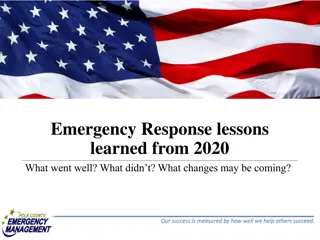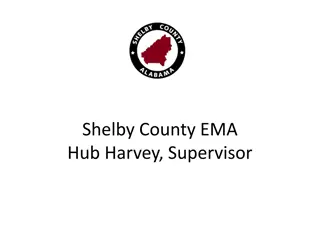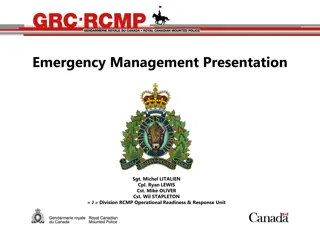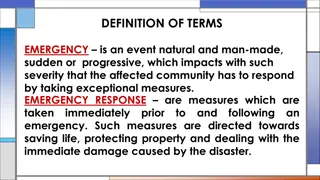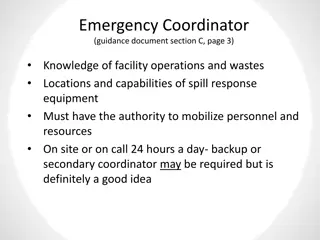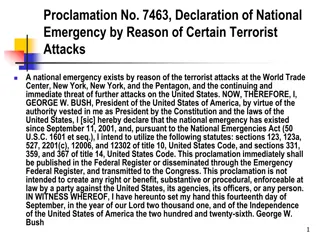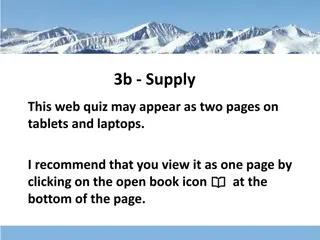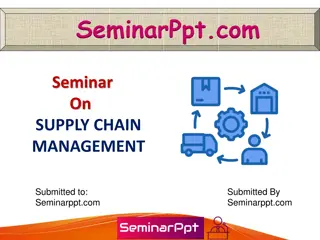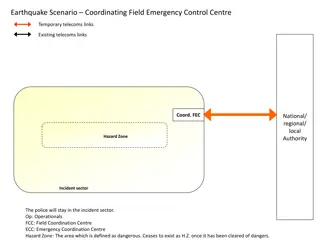Responsibilities and Collaboration in Supply Management for Emergency Response
The role of various stakeholders in supply management for emergency response is crucial. The Nutrition Cluster Coordinator (NCC) coordinates with partners to identify and address supply needs, while Information Management Officer (IMO) supports in calculating caseloads and consolidating supply requests. Additionally, cluster partners share information to ensure overall needs are met, with pipeline managers monitoring supply availability and addressing potential shortages.
Download Presentation

Please find below an Image/Link to download the presentation.
The content on the website is provided AS IS for your information and personal use only. It may not be sold, licensed, or shared on other websites without obtaining consent from the author.If you encounter any issues during the download, it is possible that the publisher has removed the file from their server.
You are allowed to download the files provided on this website for personal or commercial use, subject to the condition that they are used lawfully. All files are the property of their respective owners.
The content on the website is provided AS IS for your information and personal use only. It may not be sold, licensed, or shared on other websites without obtaining consent from the author.
E N D
Presentation Transcript
4.2 4.2 Resource Mobilisation Part 3: Resource Mobilisation Part 3: Supply Supply INFORMATION MANAGEMENT Registered Charity No 1079752 RedR UK is a company limited by guarantee. Company Number 3929653
IMO Role in Resource Mobilisation stage of the HPC IMO responsibilities include support to the NCC in resource mobilisation by ensuring availability of the up-to-date information on: Financial Resources Human Resources Supplies
Supply The procurement, transport and distribution of commodities necessary for programme implementation to meet the affected population s needs.
Role of NCC Coordinatebetween Nutrition Cluster partners to ensure that overall supply and equipment needs for the emergency response are regularly identified and that the Nutrition Cluster as a whole can identify and address any pipeline issues ( stock- out , temporary gaps, etc.).
In practical terms, the NCC responsibilities are to: Identify supply needs and update planning figures (based on the HRP) Promote standards for nutrition supplies and equipment. Facilitate information exchange on type/quantity of supplies/equipment. Anticipate import procedures and requirements. Manage products and facilitate the planning for preposition and delivery of supplies.
In practical terms, the IMO responsibilities are to: Support NCC and cluster partners in calculating caseload, targets and supplies for the nutrition cluster response by providing technical assistance Consolidate supplies needs, availability and gaps and share with partners Consolidate nutrition cluster requests for supplies to be shared with logistics cluster
What is the role of cluster partners in supply? Share information with the NCC to ensure that overall Nutrition Cluster needs for stocks of supplies and equipment are identified. Pipeline managers: share information on supplies availability and gaps. This includes information on expected pipeline breaks, risks of shortage, etc. Note: Some agencies have their own independent supply/equipment pipelines and do not necessarily participate in joint supply planning via the Nutrition Cluster. However, these agencies are still encouraged to share! Willingness to make temporarily available supplies to other organisations ( lending )
Which supplies? Supplies to: treat and prevent SAM and MAM address or prevent micronutrient deficiencies (iron/folate, sprinkles, vitamin A, etc.) meet needs for IYCF-E (BMS, baby-tents, etc.)
Exercise: Terminology Carousel Agree and record a definition for the term on the flip chart you are standing beside: People Affected People in Need People Targeted People Reached People Covered When you move to the next flip chart, add to or edit the definition that is already there.
Affected people include all those whose lives have been affected in some way by the crisis. Not all affected people are in need of humanitarian assistance. This figure is often the first available after a sudden onset emergency but says little about the number of people in need for humanitarian aid
People in need include those affected people who require humanitarian assistance in some form. People in need represent a sub-group of affected people and may differ from sector to sector. Establishing this figure across sectors often requires a method and collaborative analytical process People in Need = Caseload
The need perspective also includes the diversified need from different groups of people, women and men, based on their age and sex, physical and mental ability and identity, social-economic background, risks of violence and vulnerabilities etc.
People targeted include all people the cluster system is trying to assist. This will likely be a sub-group of people in need, as there are many actors providing assistance that do not participate in the cluster system (affected communities, national authorities, Red Cross/Red Crescent movement, and NGOs).
The targeted people can be prioritized within the affected population and the vulnerable groups e.g. pregnant and lactating mothers, children and infants based on their nutritional and live-saving requirements.
People reached include those who have received some form of assistance from a cluster member. This figure says nothing about how long and how well this assistance covers the needs of the beneficiary. A more meaningful picture provides the estimate of people covered.
People covered indicates the number of people whose needs, defined by a humanitarian standard such as Sphere, have been met. E.g. There is a significant difference between the two statements: 1,000 people received water (people reached), or 1,000 people received enough water to cover their needs (15 litres per day) for the next two weeks.
Caseload, targets and supplies calculation tool INFORMATION MANAGEMENT Registered Charity No 1079752 RedR UK is a company limited by guarantee. Company Number 3929653
What GNC IM Tools inform the Resource Mobilisation stage? Financial tracking HRP tips Caseload targets & supplies calculator Capacity mapping IM Checklist
Caseloads, targets and supplies calculation tool The Caseload, targets and supplies calculation tool is designed to support calculations for planned an NC intervention. It is meant to give the cluster coordinator and partners an overview of affected population in need, population targeted with NC interventions and main supplies needed to reach the target CMAM Other interventions (BSFP, MN programmes, IYCF-E, etc.) Selected supplies CMAM Summary Other interventions summary The data is entered by NCC or IMO during planning and resource mobilization stages May need to be adapted to take national standards into account
Exercise Part 1: Caseload targets calculation Estimate the caseload and cluster target for SAM treatment (children 6-59 months) MAM treatment (children 6-59 months) BSFP (children 6-23 months) IYCF counselling (caregivers of children 0-23 months) use NC Caseload targets and supplies calculator in IM toolkit folder and 4.3 R Caseload Calculation Exercise Data in 4.3 Res Mob Part 3. Supply folder
Exercise Part 2: Supply calculations Estimate the number of essential commodities needed for the activities






